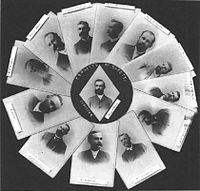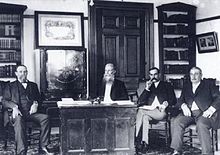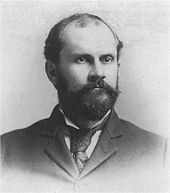- Hawaiian League
-
For other Committees of Safety, see Committee of Safety (disambiguation).
Hawaiian League 
Formation 1887 Extinction 1893 (succeeded by Provisional Government) Type Secret society Purpose/focus Overthrow of the government of Hawaii, annexation by the United States Location Honolulu, Hawaii Membership elite Caucasian business and political leaders Official languages English Unofficial leader Lorrin A. Thurston Main organ Committee of Thirteen,
Committee of SafetyParent organization Hawaii Republican Party Affiliations Honolulu Rifles The Committee of Safety, formally the Citizen's Committee of Public Safety, was a 13-member group of the Hawaiian League also known as the Annexation Club. The group was composed of American, Hawaiian, and European citizens who were members of the Missionary Party, as well as American and European residents in the Kingdom of Hawaiʻi that planned and carried out the overthrow of the Kingdom of Hawaiʻi on January 17, 1893. The goal of this group was to achieve annexation of Hawaiʻi to the United States. The new independent Republic of Hawaiʻi government was thwarted in this goal by the administration of President Grover Cleveland, and it was not until 1898 that the United States Congress approved a joint resolution of annexation creating the U.S. Territory of Hawaiʻi.
Contents
Formation
The Committee of Safety originated from a leadership group when members Missionary Party began to run as Independent Party candidates. For the elections of 1884 the Missionary Party strictly ran all candidates as Independent Party candidates. To ensure that Missionaries were on the Independent ticket the “Committee of Nine” was formed April 16, 1883, to assume the leadership position of the Independent Party. The Committee of Nine were staunchly loyal to the Missionary Party, having social and economic philosophies that reflected the Missionary values. The Independent Party won 13 seats and was the minority party in the Hawaii legislature. For the following elections of 1886 the committee reconvened, this time calling themselves the “Committee of Thirteen” due to the change in members. Their intent was to make the Independent Party the majority party in the legislature. At the end of the elections the Independents won ten seats, a net loss of three seats.
The movement
In January 1887 the Committee of Thirteen formed a secret society called the Hawaiian League. No official records were kept, but Lorrin A. Thurston (the grandson of American missionaries Asa Thurston and Lorrin Andrews) drafted the group's constitution. The group was headed by an executive committee of lawyers and businessmen mostly of American descent. Membership grew through the year, including some German and British citizens, and a few part-Hawaiians. Although the politicians changed the name of their party from "Missionary" to "Reform", many wanted to become part of the United States, not just reform the monarchy.[1]:347–350 This was why the Hawaiian League was also called the Annexation Club, although not often in public.
The Hawaiian League came into control of the Honolulu Rifles. Made of about 200 armed local (non-native) men, who fought under the command of enthusiastic annexationist Volney V. Ashford.[1]:352–353 In June 1887 the Hawaiian League used the Rifles to force King Kalākaua to enact the Bayonet Constitution which limited his power. After Queen Liliʻuokalani came to power in 1891, she attempted to restore power to the throne. This caused the group to act again.
Overthrow
See also: Overthrow of the Kingdom of HawaiiThe precipitating event[1]:582 leading to the overthrow was the attempt by Queen Liliʻuokalani to promulgate a new constitution which would have strengthened the power of the monarch relative to the legislature in which Euro-American business elites held disproportionate power, a political situation that was a direct result of the 1887 constitution. The conspirators' stated goals were to depose the queen, overthrow the monarchy, and seek Hawaii's annexation to the United States.[1]:353,587–88
On January 16, the Marshal of the Kingdom Charles B. Wilson was tipped off to the imminent planned coup. Wilson requested warrants to arrest the 13 member Committee of Safety, and put the Kingdom under martial law. Because the members had strong political ties with United States Government Minister John L. Stevens, the requests were repeatedly denied, fearing if approved, the arrests would escalate the situation. After a failed negotiation with Thurston,[2] Wilson began to collect his men for the confrontation. Wilson and Captain of the Royal Household Guard, Samuel Nowlein, had rallied a force of 496 men who were kept at hand to protect the Queen.
The Revolution ignited on January 17 when a policeman was shot and wounded while trying to stop a wagon carrying weapons to the Honolulu Rifles. The Committee of Safety feared the shooting would bring government forces to rout out the conspirators and stop the coup before it could begin. The Rifles garrisoned Ali'iolani Hale across the street from ʻIolani Palace and waited for the queen’s response.
As these events were unfolding, the Committee of Safety expressed concern for the safety and property of American residents in Honolulu. United States Government Minister John L. Stevens, advised about these supposed threats to non-combatant American lives and property[3] by the Committee of Safety, obliged their request and summoned a company of uniformed U.S. Marines from the USS Boston and two companies of U.S. sailors to land on the Kingdom and take up positions at the U.S. Legation, Consulate, and Arion Hall on the afternoon of January 16, 1893. 162 sailors and Marines aboard the USS Boston in Honolulu Harbor came ashore well-armed but under orders of neutrality. The sailors and Marines did not enter the Palace grounds or take over any buildings, and never fired a shot, but their presence served effectively in intimidating royalist defenders. Historian William Russ states, "the injunction to prevent fighting of any kind made it impossible for the monarchy to protect itself."[4] Due to the Queen's desire "to avoid any collision of armed forces, and perhaps the loss of life" for her subjects and after some deliberation, at the urging of advisers and friends, the Queen ordered her forces to surrender. The Honolulu Rifles took over government buildings, disarmed the Royal Guard, and declared a Provisional Government.
 Executive council of the Provisional Government (left to right): James A. King, Sanford B. Dole, W. O. Smith and P. C. Jones
Executive council of the Provisional Government (left to right): James A. King, Sanford B. Dole, W. O. Smith and P. C. Jones
The Hawaiian League unofficially adopted the American Flag to appeal to the US and promote annexation. The flag was raised over ʻIolani Palace by Stevens on January 17, 1893. The flag was eventually lowered by James H. Blount that April for spreading a false presumption that the US had taken control.
International Response
During the overthrow, the Japanese Imperial Navy gunboat Naniwa was docked at Pearl Harbor. The gunboat's commander, Heihachiro Togo, who later commanded the Japanese battleship fleet at Tsushima, refused to accede to the Provisional Government's demands that he strike the colors of the Kingdom, but later lowered the colors on order of the Japanese Government. Along with every other international legations in Honolulu, the Japanese Consulate-General, Suburo Fujii, quickly recognized the Provisional Government as the legitimate successor to the monarchy.[5]
Every government with a diplomatic presence in Hawaii recognized the Provisional Government within 48 hours of the overthrow, including the United States, although the recognition by the United States government and its further response is detailed in the section above on "American Response". Countries recognizing the new Provisional Government included Chile, Austria-Hungary, Mexico, Russia, the Netherlands, Germany, Sweden, Spain, Japan, Italy, Portugal, Great Britain, Denmark, Belgium, China, Peru, and France.[6] When the Republic of Hawaii was declared on July 4, 1894, immediate recognition was given by every nation with diplomatic relations with Hawaii, except for Britain, whose response came in November 1894.[7]
Members of the committees
Committee of Nine
- Joseph B. Atherton
- William R. Castle
- John H. Paty
- William O. Smith
- James A. Hopper
- Peter C. Jones
- Sanford B. Dole
- William W. Hall
- Henry W. Mist
Committee of Thirteen
- Joseph B. Atherton
- John H. Paty
- William R. Castle
- Peter C. Jones
- Charles J. Austin
- Benjamin F. Dillingham
- Sanford B. Dole
- Lorrin A. Thurston
- William W. Hall
- Henry F. Glade
- Thomas May
- William H. Bailey
- George N. Wilcox
Committee of Safety
Signatories of the January 16 letter:
- Henry Ernest Cooper, American citizen who arrived in 1890, named chairman at mass meeting January 14, 1893
- Crister Bolte, German national, Hawaiian subject, member
- Andrew Brown, Scottish national, member
- William Richards Castle, born in Honolulu 1849, attorney general for Kalākaua 1876, Hawaiian legislator 1878-88, member
- John Emmeluth, American citizen, member
- Theodore F. Lansing, American citizen, member
- John A. McCandless, American, naturalized Hawaiian subject, member
- Frederick W. McChesney, American citizen, member
- William Owen Smith, born on Kauaʻi 1838 of American missionaries, member
- Lorrin A. Thurston, born in Hawaii of American grandparents, member
- Edward Suhr, German citizen, member
- Henry Waterhouse, Hawaiian subject of Tasmanian birth, came to Hawaiʻi 1851, member
- William C. Wilder, American, Hawaiian subject, brother of Samuel Gardner Wilder, member
Others who assisted in the overthrow:
- Charles L. Carter, American, naturalized Hawaiian subject, member, son of Henry A. P. Carter, brother of George R. Carter, died during the 1895 counter-revolution
- Samuel Mills Damon, Hawaiian subject with American parents, vice president of Provisional Government
- Sanford B. Dole, American, naturalized Hawaiian subject, selected to head Provisional Government and Republic
- Peter Cushman Jones, American, naturalized Hawaiian subject, provisional government minister of finance
- James A. King, Scottish national, named minister of interior
See also
- 1887 Constitution of the Kingdom of Hawaii
- Reform Party of the Hawaiian Kingdom
- Provisional Government of Hawaii
- Republic of Hawaii
- Territory of Hawai'i
References
- ^ a b c d Ralph Simpson Kuykendall (1967). Hawaiian Kingdom 1874-1893, the Kalakaua Dynasty. 3. University of Hawaii Press. ISBN 9780870224331. http://www.ulukau.org/elib/cgi-bin/library?c=kingdom3&l=en.
- ^ Twombly, Alexander (1900). Hawaii and its people. Silver, Burdett and company. p. 333.
- ^ Kinzer, S. (2006) America's Century of Regime Change from Hawaii to Iraq. p. 30. [Minister Stevens] "certainly overstepped his authority when he brought troops ashore, especially since he knew that the 'general alarm and terror' of which the Committee of Safety had complained was a fiction."
- ^ William Adam Russ (1992). The Hawaiian Revolution (1893-94). Associated University Presses. p. 350. ISBN 0945636431.
- ^ The Morgan Report, p1106-1107, "The receipt of your communication, dated the 17th instant, inclosing a copy of proclamation issued on the same day, informing me that for reasons set forth in said proclamation the Hawaiian monarchy has been abrogated and a Provisional Government established, which is now in possession of the Government departmental buildings, the archives, and the treasury, and requesting me on behalf of H. I. J. M.'s Government to recognize said Provisional Government as the de facto Government of the Hawaiian Islands, pending the receipt of instructions from H. I. J. M.'s Government, to whom advices of your action and of the position which I have taken in relation thereto have been despatched."
- ^ The Morgan Report, p 1103-1111
- ^ Andrade, Ernest (1996). The Unconquerable Rebel. The University Press of Colorado. pp. 147. ISBN 0870814176. "The provisional government, whatever its faults, had had little difficulty in obtaining recognition, even from Cleveland, and it was not considered likely that the republic would have any foreign problems. Recognition came even more quickly than it had in 1893, for at least there was no question of a revolution's having taken place or of the government's control of the domestic situation."
Further reading
- Liliuokalani, 1990, Hawaii's Story by Hawaii's Queen, ISBN 978-0-935180-85-5
History of Hawaii 
This article is part of a seriesTimeline Ancient Kingdom of Hawaii Provisional Cession Kingdom of Hawaii Provisional Government Republic of Hawaii American Hawaii Territory State of Hawaii
Hawaii Portal
Categories:
Wikimedia Foundation. 2010.

